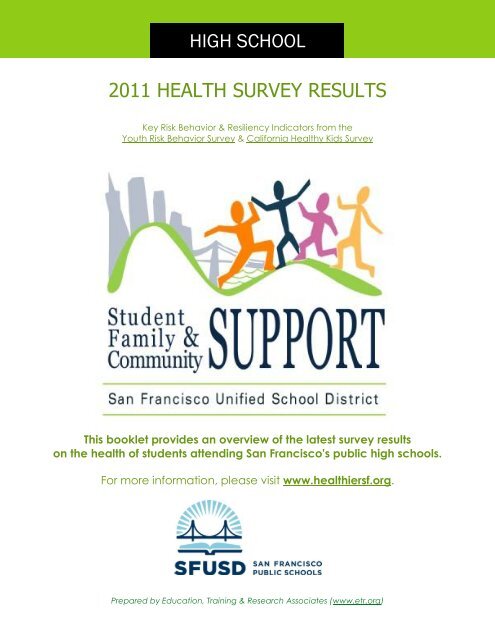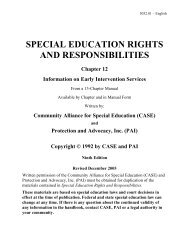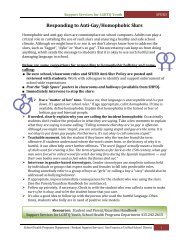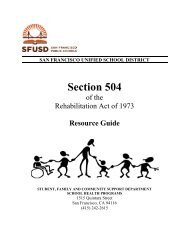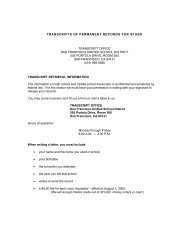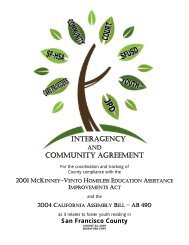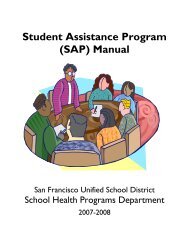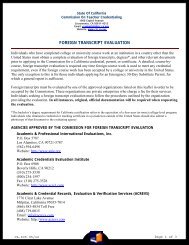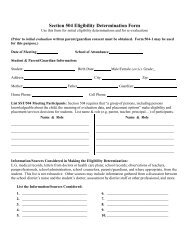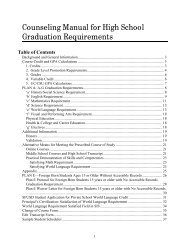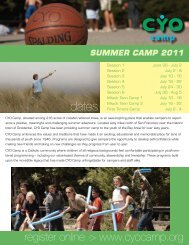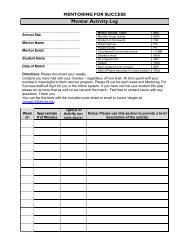2011 High School YRBS Results
2011 High School YRBS Results
2011 High School YRBS Results
You also want an ePaper? Increase the reach of your titles
YUMPU automatically turns print PDFs into web optimized ePapers that Google loves.
HIGH SCHOOL<strong>2011</strong> HEALTH SURVEY RESULTSKey Risk Behavior & Resiliency Indicators from theYouth Risk Behavior Survey & California Healthy Kids SurveyThis booklet provides an overview of the latest survey resultson the health of students attending San Francisco's public high schools.For more information, please visit www.healthiersf.org.Prepared by Education, Training & Research Associates (www.etr.org)
ABOUT THIS REPORTAcknowledgements. Our special thanks go to all the SFUSD high school students who tookthe time to complete the surveys so that we might better understand how to reduce futurehealth risks and support student achievement. In addition, our sincere thanks to all theprincipals, teachers, and other school personnel who facilitated the administration of thesurveys.This project was funded by the Centers for Disease Control & Prevention (CDC), CooperativeAgreement 1U87DP001177-01, the California Department of Education (CDE), and the SanFrancisco Unified <strong>School</strong> District‘s Student, Family, and Community Support Department(SFCSD). Education, Training & Research Associates (ETR) managed the administration of thesurveys and produced this booklet in collaboration with SFCSD.About the <strong>Results</strong>. The <strong>YRBS</strong> results presented in this booklet have been statistically weightedand are representative of all students in grades nine through twelve attending public highschools in San Francisco. CHKS results, which are not weighted, are representative of 9 th and11 th grade students only. In this booklet, information about health risk behavior comes fromthe <strong>YRBS</strong>, while information about youth development assets and resiliency comes from theCHKS.About the Youth Risk Behavior Survey (<strong>YRBS</strong>). The <strong>YRBS</strong> was developed in 1990 by the Centersfor Disease Control and Prevention (CDC) to monitor priority health risk behaviors thatcontribute to the leading causes of death, disability, and social problems among youth andadults in the United States. These behaviors, often established during childhood and earlyadolescence, include: (1) violence and unintentional injuries; (2) tobacco use; (3) alcoholand other drug use; (4) sexual behaviors; (5) diet and weight management; and (6) physicalactivity.The <strong>2011</strong> <strong>High</strong> <strong>School</strong> <strong>YRBS</strong> was administered to a random sample of 2,220 students in gradesnine through twelve in 20 public high schools in San Francisco. The overall response rate was74%. Based on guidelines from the CDC, response rates of 60% or greater are consideredgeneralizable to the population from which the sample was drawn. More information aboutthe <strong>YRBS</strong> can be found at www.cdc.gov/yrbs.About the California Healthy Kids Survey (CHKS). The CHKS was developed under contractfrom CDE by WestEd in collaboration with Duerr Evaluation Resources, assisted by anAdvisory Committee of researchers, teachers, school prevention and health programpractitioners, and public agency representatives. The Healthy Kids Survey is a youth selfreportdata collection system that provides essential health risk assessment and resilienceinformation to schools, districts, and communities.The <strong>2011</strong> <strong>High</strong> <strong>School</strong> CHKS was administered to 5,622 students in grades nine and eleven in21 public high schools in San Francisco. More information about the CHKS can be found atwww.wested.org/chks or www.healthiersf.org.SFUSD <strong>High</strong> <strong>School</strong> Health Survey <strong>Results</strong> <strong>2011</strong> P a g e | 1
<strong>YRBS</strong> SAMPLE DEMOGRAPHICSThe following charts provide a snapshot of student demographic characteristics from the<strong>YRBS</strong> sample (n=2,220), which are representative of the demographics of all SFUSD highschool students.Figure 1: Race / EthnicityFigure 2: SexAfrican-American,9.9% Chinese,Multiple38.5%races, 2.9%All otherraces, 12.8%Female,49.3%White,8.5%Hispanic/Latino,21.1%Filipino,6.4%Male,50.7%Figure 3: Grade LevelFigure 4: AgeOther,0.9%9 th , 25.3%16, 20.4%17, 28.5%>=18, 15.1%12 th , 23.4%10 th ,26.0%
AREAS OF SUCCESS<strong>High</strong> school students reported several positive trends in health-related risk behaviors over the past 14years. There were significant positive changes (i.e., increases in health-promoting behaviors ordecreases in risk behaviors) in the following behavior areas:ViolenceThe percentage of students who report they seriouslyconsidered attempting suicide in the past year hasdecreased.The percentage of students who report being in aphysical fight on school property has decreased.Fewer students report carrying a weapon on schoolproperty.1997 †Result (%)<strong>2011</strong>Result (%)20.1 12.911.2 7.67.8 5.8Tobacco UseAlcohol UseFewer students report smoking on school property. 9.3 3.2The number of students who report ever trying acigarette has been greatly reduced.Current alcohol use (i.e., in the past 30 days) hasdecreased.Fewer students report having their first drink before age13.60.0 35.627.5 21.028.6 18.1Other DrugUseSexualBehaviorNutrition &PhysicalActivityThe percentage of students who report lifetimemarijuana use has decreased.The percentage of students who report being offered,sold, or given a drug on school property has decreased.Among currently sexually active youth, the percentagewho used injectable birth control or birth control pills toprevent pregnancy before last sexual intercourse hasincreased (2001-<strong>2011</strong>).The number of students who report watching three ormore hours of television per day has decreased (2001-<strong>2011</strong>).Percentage of students who are obese (i.e., >=95 thpercentile on Body Mass Index has decreased (2001-<strong>2011</strong>).33.0 30.137.0 28.315.4 26.545.0 26.510.3 7.4† Since 1997, unless otherwise indicated.SFUSD <strong>High</strong> <strong>School</strong> Health Survey <strong>Results</strong> <strong>2011</strong> P a g e | 3
AREAS FOR DEVELOPMENTThere were also <strong>YRBS</strong> indicators showing no significant change or significant negative trends(increases in risk behaviors or decreases in health-promoting behaviors) in the following behaviorareas:ViolenceTobacco UseThe rate of dating violence among SFUSD high schoolstudents has not changed.The percentage of student who report attemptingsuicide in the past year has not changed significantly.The percentage of students who did not go to school onone or more of the past 30 days because they felt theywould be unsafe at school or on their way to or fromschool.Among current cigarette users, the percentage whoever tried to quit smoking cigarettes during the past 12months (2001-<strong>2011</strong>).The prevalence of daily cigarette smoking hasremained unchanged among high school students(2005-<strong>2011</strong>).1997 †Result (%)<strong>2011</strong>Result (%)7.2 7.6 *7.5 9.4 *6.6 6.1 *65.1 53.9 *7.4 7.7 *Alcohol UseOther DrugUseSexualBehaviorNutrition &PhysicalActivityDrinking alcohol on school property has not changed. 5.4 5.3 *The proportion of students who report binge drinking(i.e., five or more drinks in a row) has not changed.The percentage of students who reported lifetimeecstasy use has increased (2007-<strong>2011</strong>).The percentage of students who reported lifetimeheroin use has increased (2001-<strong>2011</strong>).Among students who had sexual intercourse during thepast three months, the percentage who used acondom during last sexual intercourse has decreased(2007-<strong>2011</strong>).Fewer students report being taught about HIV/AIDSinfection in school.The percentage of students who played video orcomputer games or used a computer for somethingthat was not school work has increased (2007-<strong>2011</strong>).Fewer students report attending physical education (PE)classes daily.*Although increases or decreased were observed, the differences were not statistically-significant.†Since 1997, unless otherwise indicated.12.6 11.7 *6.7 12.1 *1.7 5.070.8 52.9 *91.8 81.138.3 43.538.2 23.7SFUSD <strong>High</strong> <strong>School</strong> Health Survey <strong>Results</strong> <strong>2011</strong> P a g e | 4
BEHAVIORS THAT LEAD TO INJURY AND VIOLENCELOCAL AND NATIONAL HEALTH FACTSSFUSD DataCDCNationalDataTwenty-two percent (22.8%) of students reported being the victim of a verbal slurbecause of their race or ethnic background in the past month.Lesbian, gay, and bisexual (LGB) students are more than twice as likely thanheterosexual students to report being bullied at school in the past year.Transgender students are at even higher risk of being bullied at school than LGBstudents.Nearly nine out every ten high school students (87%) report hearing other studentsharrassing remarks at school such as "no homo, fag, dyke, or ‗that's so gay‘‖. Fortypercent of students reported hearing slurs at school ―most of the time‖ or ―always‖.In <strong>2011</strong>, nearly 4% of students reported a suicide attempt that resulted in an injury,poisoning, or oversdose that required treatment by a doctor or nurse.An estimated 30% of secondary school students in the United States were either abully, a target of bullying, or both. 1Approximately 72% of all deaths among US adolescents aged 10-24 years areattributed to injuries from only four causes: motor vehicle crashes (30%), all otherunintentional injuries (15%), homicide (15%), and suicide (12%). 1TRENDS OVER THE PAST FOURTEEN YEARS…1997 1999 2001 2003 2005 2007 2009 <strong>2011</strong>20091997to <strong>2011</strong> to <strong>2011</strong>Compared Compared% Skipped school for fear of being unsafe at school or on the way to or from school(One or more times in the 30 days preceding the survey)SF HS 6.6 5.2 7.3 5.1 8.1 7.4 7.0 6.1 No change* No change*National 4.0 5.2 6.6 5.4 6.0 5.5 5.0 n/a n/a n/a% Been in a physical fight(One or more times during the 12 months preceding the survey)SF HS 26.6 23.4 30.9 22.0 30.5 22.8 21.8 18.7 Decreased No change*National 36.6 35.7 33.2 33.0 35.9 35.5 31.5 n/a n/a n/a% Ever seriously considered about killing themselves(One or more times during the 12 months preceding the survey)SF HS 20.1 18.1 14.0 15.7 14.1 12.8 12.4 12.9 Decreased No Change*National 20.5 19.3 19.0 16.9 16.9 14.5 13.8 n/a n/a n/a*Although increases or decreases were observed, the differences were not statistically-significant.SFUSD <strong>High</strong> <strong>School</strong> Health Survey <strong>Results</strong> <strong>2011</strong> P a g e | 5
BEHAVIORS THAT LEAD TO INJURY AND VIOLENCEPercentage of high school students who...drove a car after drinking in past 30 days4.5%were threatened or injured with a weapon at school in past yeardid not go to school because they felt unsafe at school or on theway to or from school in past 30 days (all students)7.1%6.1%did not go to school because they felt unsafe at school or on theway to or from school in past 30 days (LGB students)15.7%did not go to school because they felt unsafe at school or on theway to or from school in past 30 days (transgender students)heard other students making harrassing slurs based on sexualorientation8.8%35.6%seriously considered attempting suicide (all students)12.9%seriously considered attempting suicide (LGB students)34.3%seriously considered attempting suicide (transgender students)45.8%0% 10% 20% 30% 40% 50% 60% 70% 80% 90% 100%SFUSD PriorityAnti-LGBTQ Harassment• 40% of students reportedhearing slurs based onsexual orientation (suchas no homo, fag, dyke,or that's so gay) atschool ―most of thetime‖ or ―always‖.SFUSD PriorityIncrease <strong>School</strong> Safety• Nearly 1,000 studentsstayed home fromschool at least one timein the past monthbecause they feltunsafe at school or onthe way to or fromschool.SFUSD PriorityDecrease Suicidal Behavior• In <strong>2011</strong>, 9.4% of studentsreported a suicideattempt in the pastyear. <strong>Results</strong> also showhigher risk of suicidalbehavior amongHispanic/Latino studentsand LGBT students.SFUSD <strong>High</strong> <strong>School</strong> Health Survey <strong>Results</strong> <strong>2011</strong> P a g e | 6
TOBACCO USELOCAL AND NATIONAL HEALTH FACTSSFUSD DataCDCNationalDataOverall cigarette smoking has decreased significantly over the past fourteen yearsamong high school students.However, 35.6% of students report trying cigarettes in their lifetime, and 10.7% ofhigh school students report current smoking.Tobacco use, including cigarette smoking, cigar smoking, and smokeless tobaccouse, is the single leading preventable cause of death in the United States. (2)Every day, approximately 4,000 American youth aged 12-17 try their firstcigarette. (3) If current patterns of smoking behavior continue, an estimated 6.4million of today's children can be expected to die prematurely from a smokingrelateddisease. (4)TRENDS OVER THE PAST FOURTEEN YEARS…1997 1999 2001 2003 2005 2007 2009 <strong>2011</strong>% Lifetime cigarette use(Ever tried cigarette smoking, even one or two puffs)20091997to <strong>2011</strong> to <strong>2011</strong>Compared ComparedSF HS 60.0 55.6 48.9 43.9 42.3 36.5 35.6 35.6 Decreased No change*National 70.2 70.4 63.9 58.4 54.3 50.3 46.3 n/a n/a n/a% Current cigarette use(Smoked cigarettes on one or more of the 30 days preceding the survey)SF HS 19.1 18.7 13.3 9.4 10.9 8.0 10.4 10.7 Decreased No change*National 36.4 34.8 28.5 21.9 23.0 20.0 19.5 n/a n/a n/a% Current frequent cigarette use(Smoked cigarettes on 20 or more of the 30 days preceding the survey)SF HS 6.9 5.8 3.7 3.2 3.7 1.9 3.1 3.3 Decreased No change*National 16.7 16.8 13.8 9.7 9.4 8.1 7.3 n/a n/a n/a*Although increases or decreases were observed, the differences were not statistically-significant.SFUSD <strong>High</strong> <strong>School</strong> Health Survey <strong>Results</strong> <strong>2011</strong> P a g e | 7
TOBACCO USEPercentage of high school students who...ever tried cigarette smoking, even one or two puffs35.6%ever smoked a whole cigarette before age 13smoked cigarettes on one or more of the past 30dayssmoked daily in past 30 days8.8%10.7%7.7%smoked on school property in past 30 dayssmoked cigarettes on 20 or more of the past 30days3.2%3.3%0% 10% 20% 30% 40% 50% 60% 70% 80% 90% 100%100%Among current smokers, the percentage of students who…80%60%53.9%40%20%11.1%24.7%0%Smoked more than 10 cigarettesper dayUsually got their cigarettes from astore or gas stationTried to quit smoking in past 12monthsSFUSD PriorityDecrease Current Smoking•Although significantdecreases have beenobserved since 1997, aboutone in ten students (10.7%)continue to report currentcigarette use.SFUSD PriorityDecrease Heavy Smoking•In <strong>2011</strong>, 11% of currentsmokers reported smokingten or more cigarettes perday.SFUSD PriorityDecrease Access toCigarettes•Nearly 25% of studentsmokers reported theyusually bought theircigarettes from a store orgas station.SFUSD <strong>High</strong> <strong>School</strong> Health Survey <strong>Results</strong> <strong>2011</strong> P a g e | 8
ALCOHOL & OTHER DRUG USELOCAL AND NATIONAL HEALTH FACTSSFUSD DataCDCNationalDataStudent reports of alcohol and other drug use have decreased significantly overthe past fourteen years.More than 20% of students report current alcohol use, and 12% report bingedrinking in the previous month.Students continue to report current marijuana use (17.9%).Nationally, excessive alcohol consumption is associated with approximately 75,000deaths per year. (5)Alcohol is a factor in approximately 41% of all deaths from motor vehicle crashes. (6)Among youth, the use of alcohol and other drugs has also been linked tounintentional injuries, physical fights, academic and occupational problems, andillegal behavior. (7)TRENDS OVER THE PAST FOURTEEN YEARS…1997 1999 2001 2003 2005 2007 2009 <strong>2011</strong>20091997to <strong>2011</strong> to <strong>2011</strong>Compared Compared% Current alcohol use(Had at least one drink of alcohol on one or more of the 30 days preceding the survey)SF HS 27.5 26.5 29.1 24.5 24.0 22.3 23.6 21.0 Decreased No change*National 50.8 50.0 47.1 44.9 43.3 44.7 41.8 n/a n/a n/a% Current binge drinking(Had five or more drinks of alcohol in a row on one or more of the 30 days preceding the survey)SF HS 12.6 11.4 13.2 10.2 11.6 10.4 12.4 11.7 Decreased No change*National 33.4 31.5 29.9 28.3 25.5 26.0 24.2 n/a n/a n/a% Current marijuana use(Used marijuana one or more times during the 30 days preceding the survey)SF HS 17.1 15.2 18.3 12.5 15.6 11.4 16.0 17.9 No change* No change*National 26.2 26.7 23.9 22.4 20.2 19.7 20.8 n/a n/a n/a*Although small increases or decreases were observed, the differences were not statistically-significant.SFUSD <strong>High</strong> <strong>School</strong> Health Survey <strong>Results</strong> <strong>2011</strong> P a g e | 9
ALCOHOL & OTHER DRUG USEPercentage of high school students who...ever had at least one drink of alchohol49.1%had at least one drink of alcohol in the past 30 daysreported binge drinking in the past 30 dayshad a least one drink on school property in past 30daysever used marijuanaused marijuana one or more times in past 30 daysused marijuana on school property in past 30 daysever used any form of cocaine during their lifeever used methamphetamines during their lifeever used heroin during their lifewere offered, sold, or given an illegal drug at school21.0%11.7%5.3%30.1%17.9%6.7%7.1%5.3%5.0%28.3%0% 10% 20% 30% 40% 50% 60% 70% 80% 90% 100%SFUSD PriorityDecrease Binge Drinking• Nearly twelve percent(11.7%) of studentsreported recent bingedrinking (i.e., drinkingfive or more drinks in arow on one or more ofthe past 30 days).SFUSD PriorityDecrease Current AlcoholUse• Despite a significantreduction in currentalcohol use rates since1997, one in fivestudents (21%) still reportusing alcohol in the pastmonth.SFUSD PriorityDecrease Drugs at <strong>School</strong>• Nearly thirty percent(28.3%) of studentsreported being offered,sold, or given an illegaldrug at school.SFUSD <strong>High</strong> <strong>School</strong> Health Survey <strong>Results</strong> <strong>2011</strong> P a g e | 10
SEXUAL BEHAVIORSLOCAL AND NATIONAL HEALTH FACTSSFUSD DataCDCNationalDataTwenty-eight percent (27.8%) of students report ever having sexual intercourse intheir lifetime.About 53% of sexually-active students report using a condom during their lastsexual intercourse.Over the past fourteen years, there's been a significant decrease in thepercentage of students who report participating in HIV/AIDS education at school.Vaginal, anal, and oral intercourse place young people at risk for HIV infection andother sexually transmitted diseases (STDs). Vaginal intercourse carries the additionalrisk of pregnancy. (8)Adolescents are more likely to engage in high-risk behaviors, such as unprotectedsex, when they are under the influence of drugs or alcohol. (9)TRENDS OVER THE PAST FOURTEEN YEARS…1997 1999 2001 2003 2005 2007 2009 <strong>2011</strong>% Ever had sexual intercourse20091997to <strong>2011</strong> to <strong>2011</strong>Compared ComparedSF HS n/a 26.7 29.8 24.6 31.3 26.4 28.7 27.8 No change* No change*National 48.4 49.9 45.6 46.7 46.8 47.8 46.0 n/a n/a n/a% Condom use during last sexual intercourse(Of students who reported having sexual intercourse, used a condom during last intercourse)SF HS 57.1 56.8 62.9 65.4 66.3 70.8 56.5 52.9 No change* No change*National 56.8 58.0 57.9 63.0 62.8 61.5 61.1 n/a n/a n/a% Taught about HIV/AIDS in school(Had been taught in school about AIDS or HIV infection)SF HS 91.8 90.2 90.0 92.5 83.9 85.5 85.4 81.1 Decreased DecreasedNational 91.5 90.6 90.0 92.5 83.9 85.5 87.0 n/a n/a n/a*Although increases or decreases were observed, the differences were not statistically-significant.SFUSD <strong>High</strong> <strong>School</strong> Health Survey <strong>Results</strong> <strong>2011</strong> P a g e | 11
SEXUAL BEHAVIORSPercentage of high school students who...have ever been taught in school about AIDS or HIVinfection81.1%have ever had sexual intercourse27.8%have had sex with four or more people during theirlife7.0%had sexual intercourse before age 134.9%0% 10% 20% 30% 40% 50% 60% 70% 80% 90% 100%100%80%60%Among students who had sexual intercourse in thepast 90 days, the percentage of students who…52.9%40%20%21.0%11.5%0%drank alcohol or used drugsbefore last sexual intercourseused birth control pills duringlast sexual intercourseused a condom duringlast sexual intercourseSFUSD PriorityIncrease HIV/AIDSPreventionSFUSD PriorityIncrease Condom UseSFUSD PriorityDecrease Multiple Partners• Over the past fourteenyears, the percentageof students whoreported they learnedabout HIV/AIDS inschool has decreasedsignificantly (from 91.8%to 81.1%).• The percentage ofsexually-active studentswho reported using acondom during their lastsexual intercourse hasdecreased by 18% since2007 (from 70.8% to52.9%).• Seven percent ofstudents reportedhaving sexualintercourse with four ormore people in theirlifetime, increasing therisk of pregnancy andsexually-transmittedinfections.SFUSD <strong>High</strong> <strong>School</strong> Health Survey <strong>Results</strong> <strong>2011</strong> P a g e | 12
BODY IMAGE & HEALTHY EATINGLOCAL AND NATIONAL HEALTH FACTSSFUSD DataCDCNationalDataNearly twelve percent (11.6%) of students are overweight as measured by studentself-reports of height and weight on the <strong>YRBS</strong>. In contrast, nearly one-third ofstudents (30.2%) describe themselves as overweight.Over forty percent (43.5%) of students report they are trying to lose weight.Healthy eating is associated with reduced risk for many diseases, including thethree leading causes of death: heart disease, cancer, and stroke. (10)Healthy eating in childhood and adolescence is important for proper growth anddevelopment and can prevent health problems such as obesity, dental caries, andiron deficiency anemia. (10TRENDS OVER THE PAST FOURTEEN YEARS…1997 1999 2001 2003 2005 2007 2009 <strong>2011</strong>20091997to <strong>2011</strong> to <strong>2011</strong>Compared Compared% Overweight(95th percentile or greater for body mass index, by age and sex, based on reference data)SF HS n/a n/a 10.6 6.3 10.5 8.5 12.8 11.6 No change* No change*National n/a 10.7 10.5 12.1 13.1 13.0 15.8 n/a n/a n/a% Described themselves as slightly or very overweightSF HS 30.3 34.9 32.1 34.7 30.9 31.2 30.8 30.2 No change* No change*National n/a 30.0 29.2 29.6 31.5 29.3 27.7 n/a No change* No change*% Were trying to lose weightSF HS 41.3 43.7 44.1 44.3 41.6 42.2 44.6 43.5 No change* No change*National 39.7 42.7 46.0 43.8 45.6 45.2 44.4 n/a n/a n/a*Although increases or decreases were observed, the differences were not statistically-significant.SFUSD <strong>High</strong> <strong>School</strong> Health Survey <strong>Results</strong> <strong>2011</strong> P a g e | 13
BODY IMAGE & HEALTHY EATINGPercentage of high school students who...were obese7.4%were overweight11.6%were trying to lose weight43.5%described themselves as slightly or very overweight30.2%ate fruits and vegetables five or more times a day inthe past seven days23.4%ate fruits two or more times per day and atevegetables three or more times per day during thepast seven days13.5%0% 10% 20% 30% 40% 50% 60% 70% 80% 90% 100%*that is, each day during the week preceding the survey.SFUSD PriorityIncrease Healthy Weight• Nearly half (43.5%) ofstudents report currentlytrying to lose weight.SFUSD PriorityImprove Healthy Habits• Less than a quarter(23.4%) of students atefruits and vegetablesfive or more times a dayin the past seven days.SFUSD PriorityIncrease Healthy Eating• While 7.4% of studentsare obese based ontheir Body Mass Indexscore on the <strong>YRBS</strong>, andanother 11.6% ofstudents are overweight.SFUSD <strong>High</strong> <strong>School</strong> Health Survey <strong>Results</strong> <strong>2011</strong> P a g e | 14
PHYSICAL ACTIVITYLOCAL AND NATIONAL HEALTH FACTSSFUSD DataCDCNationalDataEighty-three percent (83.4%) of 9 th and 10 th grade students report attending therequired physical education classes at least once per school week.Although the indicator has decreased significantly over the past fourteen years,nearly one-third of students (26.5%) report watching three or more hours of TV onan average school day.Nearly half of students (43.5%) report spending three or more hours per day usingvideo games or computers for purposes other than school.Regular physical activity in childhood and adolescence improves strength andendurance, helps build healthy bones and muscles, helps control weight, reducesanxiety and stress, increases self-esteem, and may improve blood pressure andcholesterol levels. (11)Positive experiences with physical activity at a young age help lay the basis forbeing regularly active throughout life. (11)TRENDS OVER THE PAST FOURTEEN YEARS…1997 1999 2001 2003 2005 2007 2009 <strong>2011</strong>% Attended physical education classes(On one or more days in an average week when they were in school)20091997to <strong>2011</strong> to <strong>2011</strong>Compared ComparedSF HS 51.9 50.1 56.0 51.8 54.6 54.2 55.6 51.6 No change* No change*National 48.8 56.1 51.7 55.7 54.2 53.6 56.4 n/a n/a n/a% Attended physical education classes daily(Five days in an average week when they were in school)SF HS 38.2 36.0 34.3 37.0 36.4 36.0 29.1 23.7 Decreased No change*National 27.4 29.1 32.2 28.4 33.0 30.3 33.3 n/a No change* No change*% Watched television three or more hours per day(On an average school day)SF HS n/a 45.1 45.0 40.9 41.5 33.2 29.5 26.5 Decreased No change*National n/a 42.8 38.3 38.2 37.2 35.4 32.8 n/a n/a n/a*Although increases or decreased were observed, the differences were not statistically-significant.SFUSD <strong>High</strong> <strong>School</strong> Health Survey <strong>Results</strong> <strong>2011</strong> P a g e | 15
PHYSICAL ACTIVITYPercentage of high school students who...attended physical education (PE) classes on one ormore days in an average school week (9th and 10thgrades only)83.4%attended physical education (PE) classes daily in anaverage school week23.7%were physically active for an hour per day on five ormore days in the past week32.7%played video or computer games for 3 or morehours on an average school day43.5%watched 3 or more hours of TV on anaverage school day26.5%0% 10% 20% 30% 40% 50% 60% 70% 80% 90% 100%SFUSD PriorityIncrease NonrequiredPhysical Education•Nearly twenty percent(19.3%) of 11th and12th graders reportattending PE classeson one or more daysin an average schoolweek.SFUSD PriorityIncrease Participation inSports•Thirteen percent(13.4%) of studentswere physically activefor at least 60 minuteseverday in the pastweek.SFUSD PriorityIncrease Physical Activity•Over forty percent(43.5%) report playingvideo games or usinga computer forsomething other thanschool work for threeor more hours on anaverage school day.SFUSD <strong>High</strong> <strong>School</strong> Health Survey <strong>Results</strong> <strong>2011</strong> P a g e | 16
YOUTH DEVELOPMENT ASSETS IN THE SCHOOL ENVIRONMENTThis final section provides results from the CHKS on youth development assets in the schoolenvironment. SFUSD administers the Youth Development module of the CHKS every twoyears to students in the 9 th and 11 th grades. Youth development researchers emphasize theimportance of providing support and opportunities (external assets) in the form of caringrelationships, high expectations, and opportunities for meaningful participation within theschool environment. The development of assets within the school community improveshealth outcomes and academic performance. The following charts show the percentage ofSFUSD 9 th and 11 th students who scored “high” on school environment factors. Forcomparison purposes, the most recent statewide results are also included.SFUSD Grade 9 (2009) SFUSD Grade 9 (<strong>2011</strong>) California Grade 9 (2010)100%90%80%70%60%50%40%30%20%10%0%27%27%31%Caring Relationships:Adults at <strong>School</strong>43%40%47%<strong>High</strong> Expectations:Adults at <strong>School</strong>11%14%13%Opportunities forMeaningful Participation26%27%29%Total <strong>School</strong>Environment AssetsSFUSD Grade 11 (2009) SFUSD Grade 11 (<strong>2011</strong>) California Grade 11 (2010)100%90%80%70%60%50%40%30%20%10%0%32%29%38%Caring Relationships:Adults at <strong>School</strong>40%36%48%<strong>High</strong> Expectations:Adults at <strong>School</strong>15%13%17%Opportunities forMeaningful Participation30%26%34%Total <strong>School</strong>Environment AssetsSFUSD <strong>High</strong> <strong>School</strong> Health Survey <strong>Results</strong> <strong>2011</strong> P a g e | 17
References(1) CDC, NCHS. Public use data file and documentation: multiple cause of death for ICD-102005 data [CD-ROM]. 2008.(2) Fellows JL, Trosclair A, Adams EK, Rivera CC. Annual smoking attributable mortality, years ofpotential life lost and economic costs: United States 1995-1999. Morbidity and MortalityWeekly Report 2002; 51: 300-303.(3) Substance Abuse and Mental Health Services Administration. Summary of findings from the2001 National Household Survey on Drug Abuse: Volume II. Technical appendices andselected data tables. Rockville, MD: U.S. Department of Health and Human Services, 2002;NHSDA Series H-18; DHHS publication no. (SMA) 02-3759.(4) CDC. Office on Smoking and Health, 2002 calculations based upon: Smoking attributablemortality and years of potential life loss—United States, 1984. Morbidity and MortalityWeekly Report 1997; 46: 444-451.(5) U.S. Department of Health and Human Services. The Surgeon General's Call to Action toPrevent and Reduce Underage Drinking. U.S. Department of Health and Human Services,Office of the Surgeon General, 2007.(6) CDC. Alcohol-attributable deaths and years of potential life lost—United States, 2001.Morbidity & Mortality Weekly Report 2004; 53(37): 866–870.(7) U.S. Department of Transportation. Fatality Analysis Reporting System (FARS) Web-basedEncyclopedia.(8) CDC. Accessed at http://www.cdc.gov/healthyyouth/sexualbehaviors/index.htm.(9) Leigh B, Stall R. Substance use and risky sexual behavior for exposure to HIV: issues inmethodology, interpretation, and prevention. American Psychologist 1993; 48: 1035–1043.(10) U.S. Department of Health and Human Services. The Surgeon General's call to action toprevent and decrease overweight and obesity. Rockville, MD.: U.S. Department of Healthand Human Services, Public Health Service, Office of the Surgeon General, 2001.(11) CDC. Physical Activity and Health: A Report of the Surgeon General. Atlanta, GA: U.S.Department of Health and Human Services, 1996.SFUSD <strong>High</strong> <strong>School</strong> Health Survey <strong>Results</strong> <strong>2011</strong> P a g e | 18
<strong>2011</strong> HIGH SCHOOL HEALTH SURVEY RESULTSHealth surveys are used by SFUSD's Student, Family, and Community SupportDepartment (SFCSD) to monitor health risk behaviors of San Francisco‘s youth,guide program planning, and evaluate school-based health programs. <strong>Results</strong>from these surveys support the District's Balanced Scorecard by assisting SFCSDto understand our diverse student population. In addition, they identify areas ofgrowth and areas that need improvement in addressing student health andwellness needs, which supports increased student access to health-relatededucational programs and services.Access & Equity:Make social justice a realityStudent Achievement:Engage high achieving and joyful learnersAccountability:Keep our promises to students and familiesFor more information, please visit www.healthiersf.orgSFUSD <strong>High</strong> <strong>School</strong> Health Survey <strong>Results</strong> <strong>2011</strong> P a g e | 19


